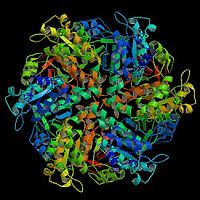
Photo from wikipedia
Systematic analysis of tumor transcriptomes, combined with deep genome sequencing and detailed clinical assessment of hundreds of patients, constitutes a powerful strategy aimed to identify potential biomarkers and therapeutic targets… Click to show full abstract
Systematic analysis of tumor transcriptomes, combined with deep genome sequencing and detailed clinical assessment of hundreds of patients, constitutes a powerful strategy aimed to identify potential biomarkers and therapeutic targets to guide personalized treatments. Oncogenic signaling cascades are integrated by multidomain effector proteins such as P-Rex1, a guanine nucleotide exchange factor for the Rac GTPase (RacGEF), known to promote metastatic dissemination of cancer cells. We hypothesized that patients with high P-Rex1 expression and reduced survival might be characterized by a particular set of signaling proteins co-expressed with this effector of cell migration as a central component of a putative signaling hub indicative of poor prognosis. High P-Rex1 expression correlated with reduced survival of TCGA Lower Grade Glioma (LGG) patients. Thus, guided by PREX1 expression, we searched for signaling partners of this RacGEF by applying a systematic unbiased in silico data mining strategy. We identified 30 putative signaling partners that also correlated with reduced patient survival. These included GPCRs such as CXCR3, GPR82, FZD6, as well as MAP3K1, MAP2K3, NEK8, DYRK3 and RPS6KA3 kinases, and PTPN2 and PTPN22 phosphatases, among other transcripts of signaling proteins and phospho-substrates. This PREX1 signaling hub signature correlated with increased risk of shorter survival of LGG patients from independent datasets and coincided with immune and endothelial transcriptomic signatures, indicating that myeloid infiltration and tumor angiogenesis might contribute to worsen brain tumor pathology. In conclusion, P-Rex1 and its putative signaling partners in LGG are indicative of a signaling landscape of the tumor microenvironment that correlates with poor prognosis and might guide the characterization of signaling targets leading the eventual development of immunotherapeutic strategies.
Journal Title: Frontiers in Oncology
Year Published: 2022
Link to full text (if available)
Share on Social Media: Sign Up to like & get
recommendations!